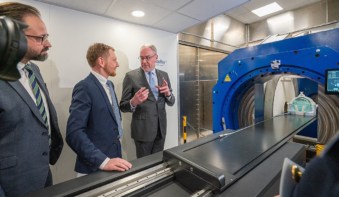
A laser that modulates its own frequency has been unveiled by researchers in the US. The device is a new and practical application of cavity optomechanics, and the team believes that it could be used to improve the resolution and cut the size, cost and complexity of LIDAR (light detection and ranging) systems, and also find application in retinal imaging.
In cavity optomechanics, the optical modes of a laser are coupled to the mechanical modes of an oscillating cavity via radiation pressure pushing on the cavity’s mirrors. Such set-ups have been used to investigate a wide range of fundamental physics and also to produce highly accurate atomic clocks.
In a conventional cavity-optomechanics experiment, the laser light is injected from the outside and the cavity simply responds to laser frequencies that resonate with its own modes of mechanical resonance. In the new research, Connie Chang-Hasnain of the University of California, Berkeley, and colleagues teamed up with the commercial company Bandwidth10 to use the cavity of the laser itself as the mechanical resonator. These mechanical oscillations therefore change the size of the laser cavity, which alters the frequency of the laser light.
Key alterations
To maximize this effect, the researchers made two key alterations to the laser set-up. First, they replaced the traditional laser – in which the light is emitted from one of the ends of the laser cavity – with a vertical cavity surface emitting laser (VCSEL). Light is emitted from either the top or bottom of the active region of a VCSEL. This means that the distance between the mirrors is much smaller than in a conventional set-up, and that the wavelength of the laser is much more sensitive to changes in this distance.
The second alteration involves replacing one of the mirrors traditionally used in VCSELs – the multilayer “distributed Bragg reflector” – with a different type of mirror called a “high-contrast grating”. This replacement mirror was first developed in 2004 by Chang-Hasnain’s group and comprises a single layer of bars that refract light. An important feature of this mirror is that it can be considerably lighter than other mirrors. The 20 μm × 20 μm mirror used by the researchers, for example, is just 130 pg, and this makes it much easier for the laser light to move it.
Under pressure
The researchers designed the mirror to be most reflective at the frequency of the VCSEL when the mirror is at rest. The light in the laser is therefore most intense at this frequency and exerts maximum pressure on the mirror. This pushes the mirror away slightly, decreasing the frequency of the laser and thereby reducing the mirror’s reflectivity. This, in turn, reduces the laser intensity and pressure, causing the mirror to retract. Because of a slight time delay in the response of the laser to a change in the length of the cavity, the pressure does not increase immediately and the mirror overshoots, which increases the frequency of the laser. When the pressure does increase again, the mirror moves back out and overshoots again. This cycle results in a periodic, rapid oscillation of both the frequency and the power of the emitted laser light.
The researchers believe that this “self-sweeping laser” will have many practical applications. One is LIDAR, which is an imaging technique with a wide range of uses including manufacturing, remote sensing and self-driving vehicles. LIDAR involves firing light pulses at an object to determine its shape and distance based on the reflected light. To determine the time at which a particular reflected pulse was emitted, the power and frequency of the light are swept constantly. Sweeping is also used in optical coherence tomography (OCT) when surveying the back of the eye to check for signs of disease.
Energy-efficient
Today, swept lasers for LIDAR and OCT use a mechanical motor to move one of the mirrors, which can make the systems large and power-hungry. “[Cavity optomechanics] is heading in a new direction that’s relatively little explored,” says Albert Schliesser of the Niels Bohr Institute in Copenhagen. “The engineering applications are something that make this paper really interesting because it indicates that there are possibilities in that area.”
The research is published in Scientific Reports.



